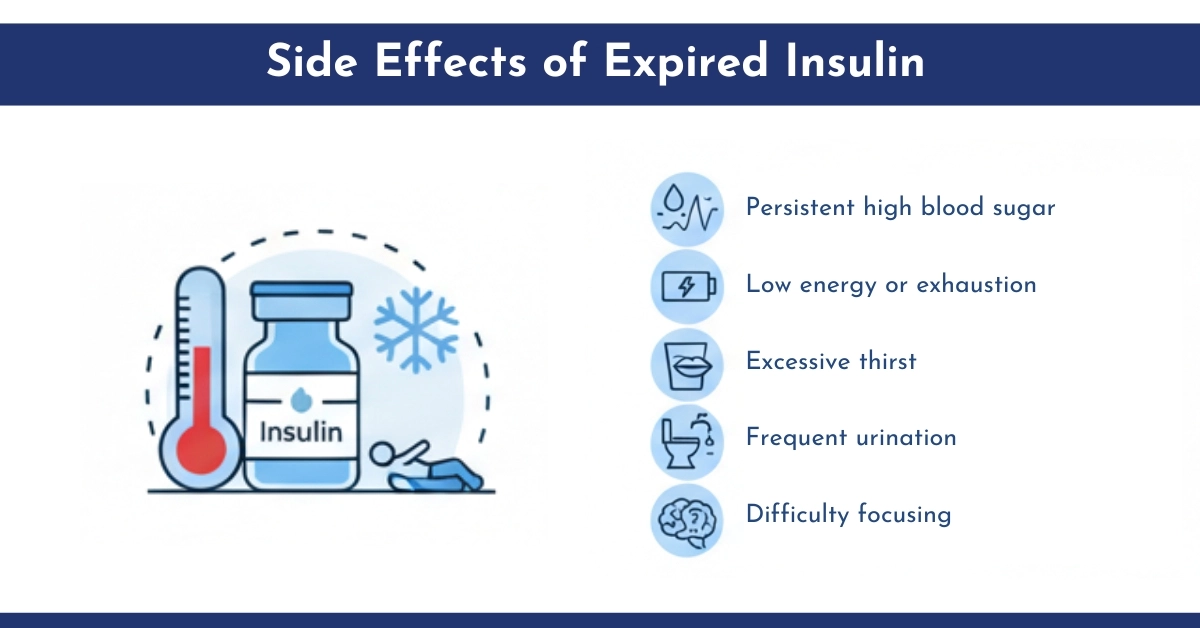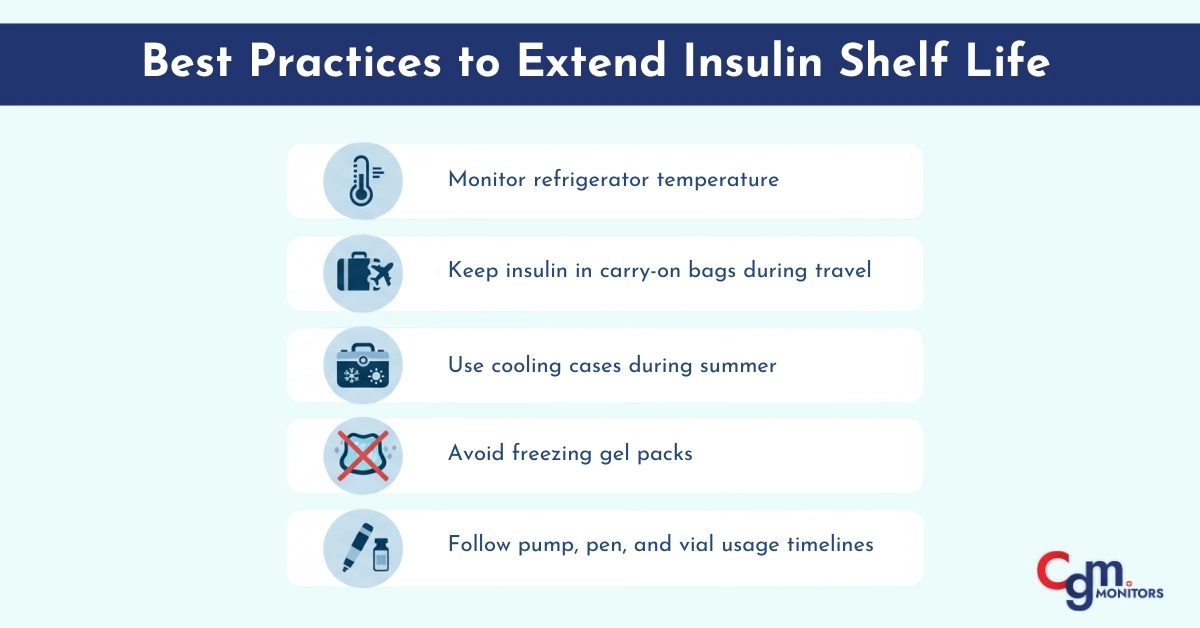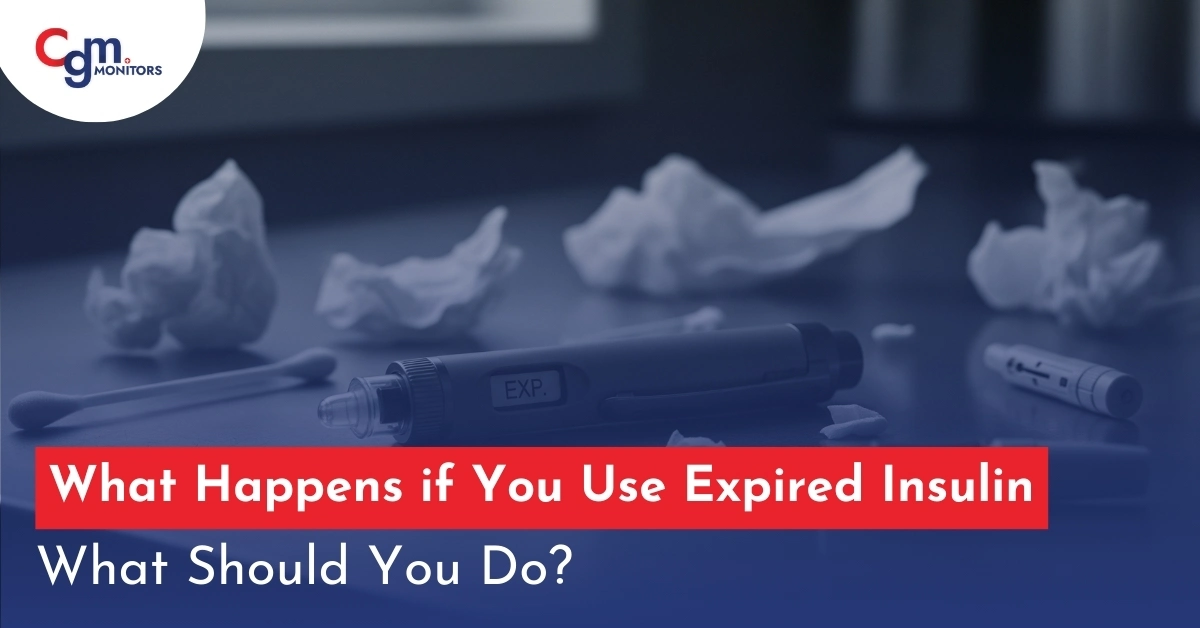Table of content
- Understanding Insulin Expiration: Two Dates to Consider
- Does Expired Insulin Still Work?
- Side Effects of Expired Insulin: Immediate and Severe Risks
- Signs That Insulin Has Gone Bad
- FDA Guidance on Expired Insulin: Experts’ Opinion
- Safe Disposal of Expired Insulin
- Insulin Storage Guidelines: Protect Your Medication
- Best Practices to Extend Insulin Shelf Life
- Cost-Saving Strategies that don’t compromise safety
- Conclusion:
- Frequently Asked Questions
If you’re asking, “What Happens if You Use Expired Insulin?”, you’re not alone—and it’s a question that deserves attention. Many people managing diabetes have found an old vial or pen tucked away and wondered if it’s still safe to use. The truth is worrying: expired insulin can lose its effectiveness, leading to unpredictable blood sugar levels and increasing the risk of serious complications.
This isn’t just about numbers—it’s about your health and safety. In this complete safety guide, we’ll explore what happens if you use expired insulin, the potential side effects, and how modern tools like insulin pumps and continuous glucose monitors (CGMs) can help you manage diabetes safely and effectively.
Understanding Insulin Expiration: Two Dates to Consider
Insulin has two separate expiration periods that every user should understand, and both directly affect insulin potency and blood sugar control
1. The Manufacturer’s Expiration Date:
- Printed on every vial, pen, or cartridge.
- Marks when the manufacturer guarantees full potency (typically 90-95%).
- Unopened insulin can last about a year if stored correctly.
2. The In-Use Expiration Date:
Once opened, insulin follows a different countdown. Depending on the type, insulin usually lasts:
| Insulin Type | Opened Shelf Life (Vial) | Opened Shelf Life (Pen) |
| Rapid-Acting (Humalog, NovoLog, Fiasp) | 28 days | 28 days |
| Short-Acting (Humulin R) | 31 days | 28 days |
| Intermediate-Acting (Humulin N) | 31 days | 14 days |
| Long-Acting (Lantus, Levemir) | 28-42 days | 28-42 days |
| Mixed Insulins (Humulin 70/30) | 31 days | 10-28 days |
Does Expired Insulin Still Work?
The short answer: Partially, yes, but not reliably.
- Expired insulin potency loss happens gradually as the molecules break apart, making it less effective at controlling blood sugar.
- Even refrigerated, insulin potency gradually declines, sometimes up to 18% in the first 28 days after opening.
- Using expired insulin can lead to high blood sugar and poor diabetes control.
A 2024 piece from Health Central notes that old insulin simply doesn’t regulate levels like it should, increasing the chance of highs.
Side Effects of Expired Insulin: Immediate and Severe Risks
The danger of expired insulin isn’t toxicity—it’s ineffectiveness. When insulin can’t do its job, your glucose rises.
Immediate Symptoms You May Notice
If you use expired insulin, you may experience:
- Persistent high blood sugar
- Low energy or exhaustion
- Excessive thirst
- Frequent urination
- Difficulty focusing
- Blurry vision
These symptoms indicate your body isn’t getting the insulin activity it needs.
Severe Health Risks
The risks of using expired insulin go beyond temporary symptoms. If blood sugar remains elevated for too long, you may develop:
- Diabetic ketoacidosis (DKA): A life-threatening emergency
- Hyperglycemic Hyperosmolar Syndrome (HHS): Common in Type 2 diabetes and extremely dangerous
Always consult your doctor, but integrating a reliable CGM monitor like Dexcom G7 (3 Pack Option) helps catch these swings. Because by using this, you can get alerts when your glucose fluctuates.

Signs That Insulin Has Gone Bad
You should always check for the signs that insulin has gone bad before injecting.
Clear Insulin Should Be:
- Completely see-through
- Free from particles
- Colorless like water
Cloudy Insulin Should Be:
- Uniformly cloudy after gentle rolling
- Free from chunks or layered separation
Red Flags That Require Immediate Disposal
Never use insulin that is:
- Discolored (pink, red, orange, or brown discoloration)
- Clumpy
- Crystalized
- Stringy or filament-like
- Separated and won’t mix
- Odd-smelling
Example: A Diabetes Voice article from 2019 shared a case where improper storage led to visible changes, causing erratic blood sugar.
FDA Guidance on Expired Insulin: Experts’ Opinion
The FDA states that insulin products in vials or cartridges may be left unrefrigerated at temperatures between 59°F and 86°F for up to 28 days and continue to work. Insulin manufacturers set expiration dates and test their products to ensure they comply with the 90% to 95% potency guidelines required by the FDA.
The FDA provides two key timeframes for insulin:
- Printed expiration date: For unopened insulin stored properly in refrigeration
- In-use expiration: Typically 28 days after opening for most insulin types
Expert Opinions
- Dr. Stephen Ponder, Pediatric Endocrinologist (Texas): Dr. Ponder, who has type 1 diabetes himself, shared that he once used a vial that expired in 2016 (three years prior) and it worked as expected, though he acknowledged taking a calculated risk (Healthline.)
- Sandra Arévalo, R.D.N., Diabetes Educator: Arévalo explains that insulin contains proteins as active ingredients that can lose their effectiveness with time, and that using expired insulin may raise the risk of developing hyperglycemia (HealthCentral)
- Michael A. Dobbins, Principal Research Scientist at Eli Lilly: Dobbins states that multiple studies are conducted to determine how long insulin can be manufactured, distributed, and used, and these expiration dates ensure the drug meets established quality standards. (Healthline)
Safe Disposal of Expired Insulin
Improper disposal can harm the environment or lead to safety hazards.
Options Include:
- Pharmacy take-back programs
- Clinic drop boxes
- FDA-approved disposal methods
- Mail-in programs for unused medication
Never: Flush insulin, throw syringes in the trash, or dispose of sharps outside proper containers
For your Information:
Medica News Today and CBS News snippets highlight ongoing risks. With vigilance, you can stay ahead.
Insulin Storage Guidelines: Protect Your Medication
Incorrect storage is one of the biggest contributors to early insulin spoilage. Follow these insulin storage guidelines carefully.
Unopened Insulin
Store in the refrigerator between 36-46°F (2-8°C).
Avoid:
- Freezing
- Direct light
- Storing near cooling vents
- Leaving it in vehicles
Opened Insulin
Once open, most insulins can remain at room temperature (under 77°F or 86°F, depending on brand). This reduces injection discomfort and keeps insulin stable. It is important to check the package insert for your specific insulin product because different insulins may have different time frames.
Avoid Heat and Freezing
Just one freeze or a few hours in high heat can destroy insulin’s molecular structure.
Many users discover their insulin has gone bad due to placement near windows, heaters, or in bags left inside hot cars.
Best Practices to Extend Insulin Shelf Life
To extend insulin life safely:
- Monitor refrigerator temperature
- Keep insulin in carry-on bags during travel
- Use cooling cases during summer
- Avoid freezing gel packs
- Follow pump, pen, and vial usage timelines
Always carry a backup pen or vial like a Tandem Mobi Insulin Cartridge (200u) or Tslim cartridge (available on CGM Monitors), when traveling—even a short trip can expose insulin to unexpected temperature changes. Moreover

Cost-Saving Strategies that don’t compromise safety
- Ask about Manufacturer coupons: Many insulin manufacturers offer patient assistance programs
- Check insurance Formularies: Generis insulin alternatives may offer significant savings
- Consider Vial vs. Pen options: If you are unable to use the entirety of the vial before 28 days is up, consider switching from vials to insulin pens, which carry less insulin volume
- Proper Storage Maximizes Shelf Life: Following storage guidelines prevents premature spoilage
- Buy Only What You Need: Work with your healthcare provider to order insulin quantities that match your usage
For your information:
Never compromise your health by using to save money. Reach out to social workers, diabetes educators, or patient advocacy groups who can connect you with assistance programs.
Conclusion:
If you are using expired insulin, which increases the risk, that is not good for your health. It is risky. Even if it looks good but it can’t work properly, which causes unpredictable blood sugar and serious problems like DKA. By storing your insulin correctly, using a CGM to monitor your blood sugar, checking for signs that insulin has gone bad, and keeping track of expiration dates, you can stay safe and protect your health.
If you think that your insulin is not working properly, stop using it and talk to your healthcare provider.
Disclaimer:
Information in this blog is meant to support general understanding of diabetes and insulin management. It is not intended to diagnose, treat, or replace advice from a qualified medical professional. Certain images in this article have been AI-generated to illustrate concepts.
Frequently Asked Questions
Can you use insulin 1-2 days after it expires?
Only in extreme emergencies and only if stored correctly, but replacement should happen immediately.
What temperature ruins insulin?
Freezing or heating above 86°F/30°C for most insulins.
Does expired insulin still work at all?
Yes, it may work partially but it is unreliable and unsafe for consistent therapy.
How can I tell if insulin has gone bad?
Look for discoloration, particles, crystals, clumps, or unpredictable blood sugar spikes.
What should I do if I injected expired insulin?
Use a CGM or meter to monitor closely for several hours and contact your healthcare team if levels stay high.







Write a comment
Your email address will not be published. All fields are required